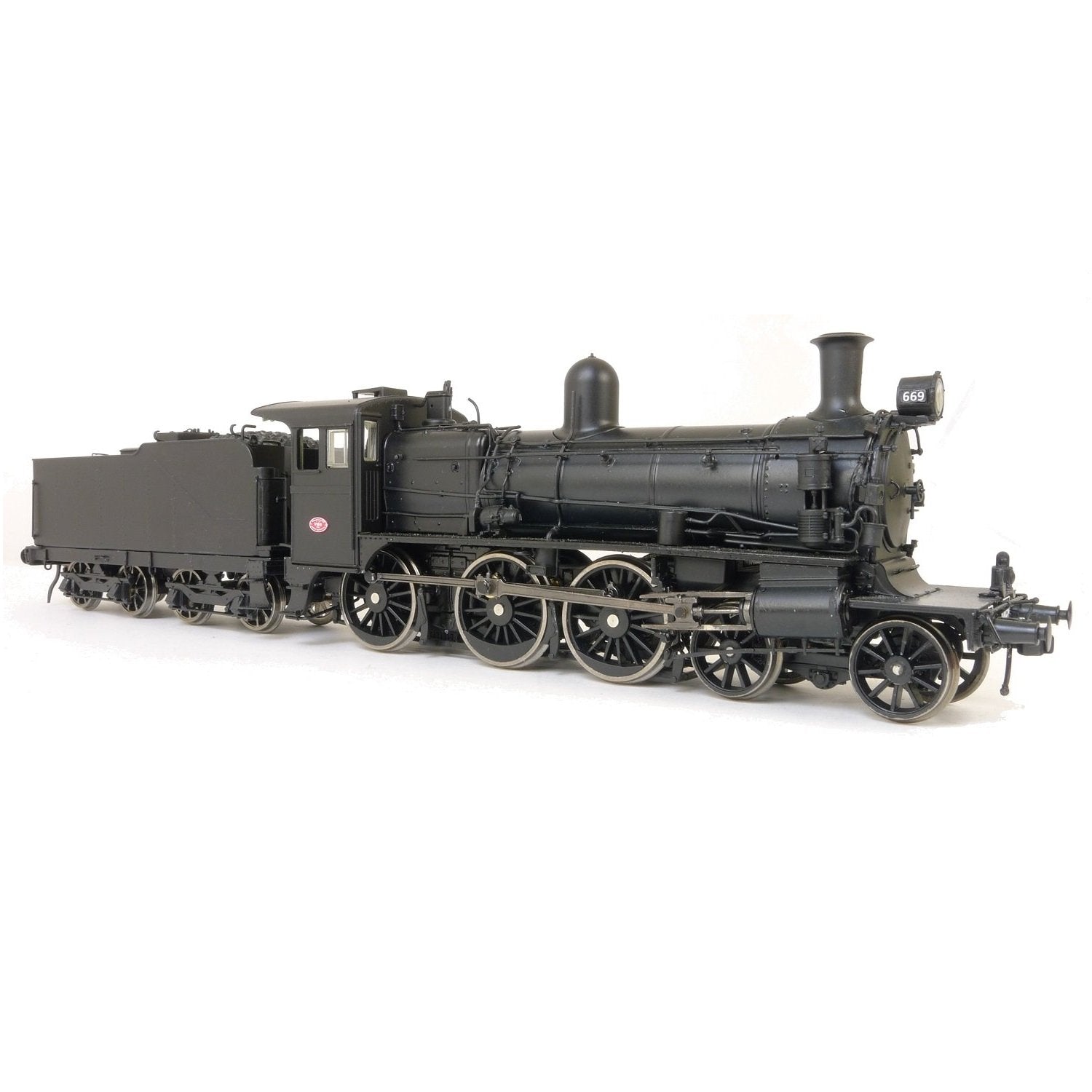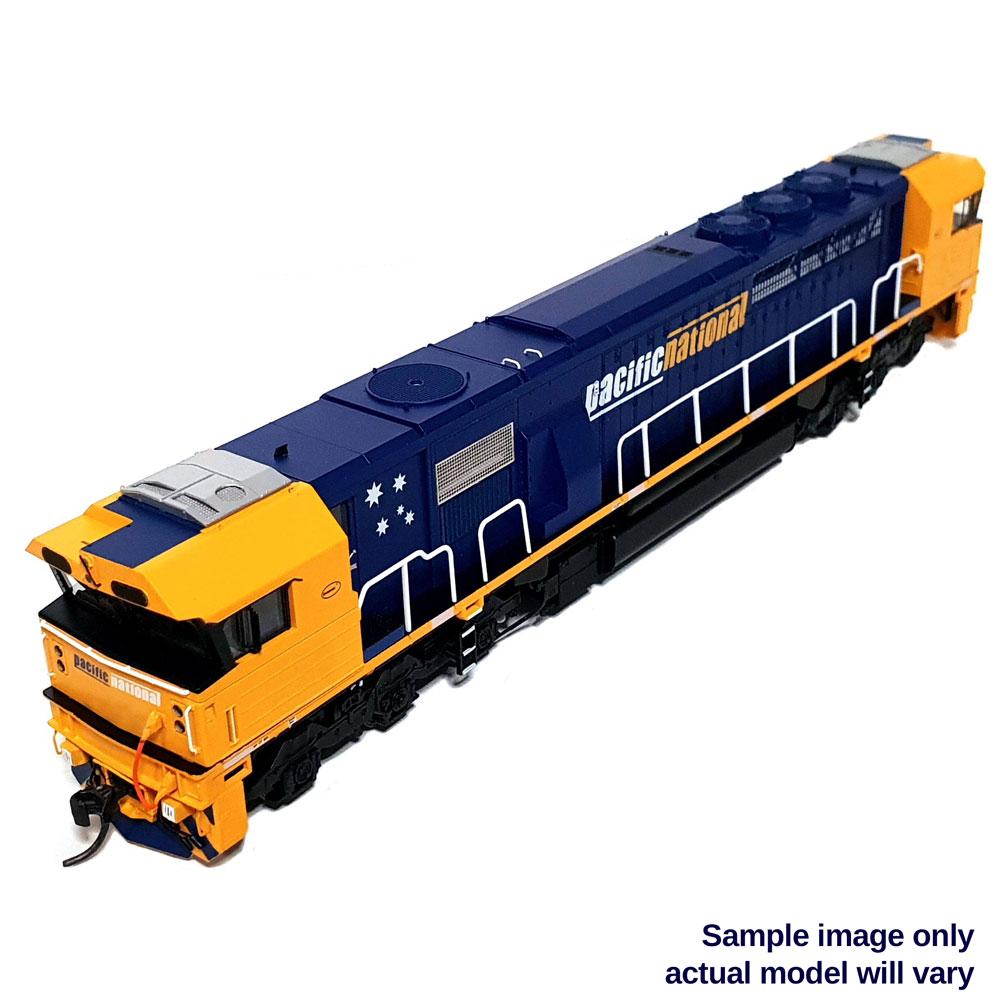
On Track Models HO 8222 Pacific National 82 Class Locomotive
Sample image supplied for illustration purposes only. Actual model will display authentic numbering and will vary.
With the introduction of these locomotives a wide spread reduction of the NSW locomotive fleet had begun. The first casualties were the veteran fleet of 44 class Alco’s, then the 45 and 442 classes along with the Mark I 48 class. Further reductions to the locomotive occurred with the withdrawals of the 422 and 49 classes.
This overall fleet reduction reduced the average age of Freight Rail’s locomotive fleet from over twenty five year old to approximately ten.
These locomotives have travelled all over NSW and have ventured into Queensland and Victoria on intermodal freight services, and in South Australia on the Leigh Creek coal service. They are currently seen on both coal and wheat services all over the state, through Sydney, and the occasional local trip train around the Sydney metropolitan area.
On Track Models is pleased bring you this highly desired locomotive as a highly detailed model in HO Scale.
Improvements:
- ESU designed PCB with two sugar cube speakers
- Independent working headlights, white and red marker lights (DCC only)
- See through Dynamic blower housing with box
- Improved one-piece MU cables
- Improved air hoses
- Improved axles bushes for better electrical pick up
- Factory Painted & Decorated in new PN livery
Standard Features:
- Ready-to-Run
- Scale AMRA Profile Metal Wheels
- All wheel drive - All wheel pick up
- 18"" Recommended minimum radius
- Highly detailed bogies with separately applied parts
- Easy access to the DCC 21 pin plug
- Easy body removal
- Quality 5 pole skew wound motor
- Die cast metal chassis with recesses for twin speakers
- Twin brass flywheels
- Etched metal detail parts
- Separately applied metal parts
- Genuine Kadee Metal Couplers
- Detailed cab interrior
- Operational headlights, foglights, & marker lights
- Compatible with Code 70, 83, & 100 Rail
- Accurate Paint Schemes & Printing
- Factory Painted & Decorated
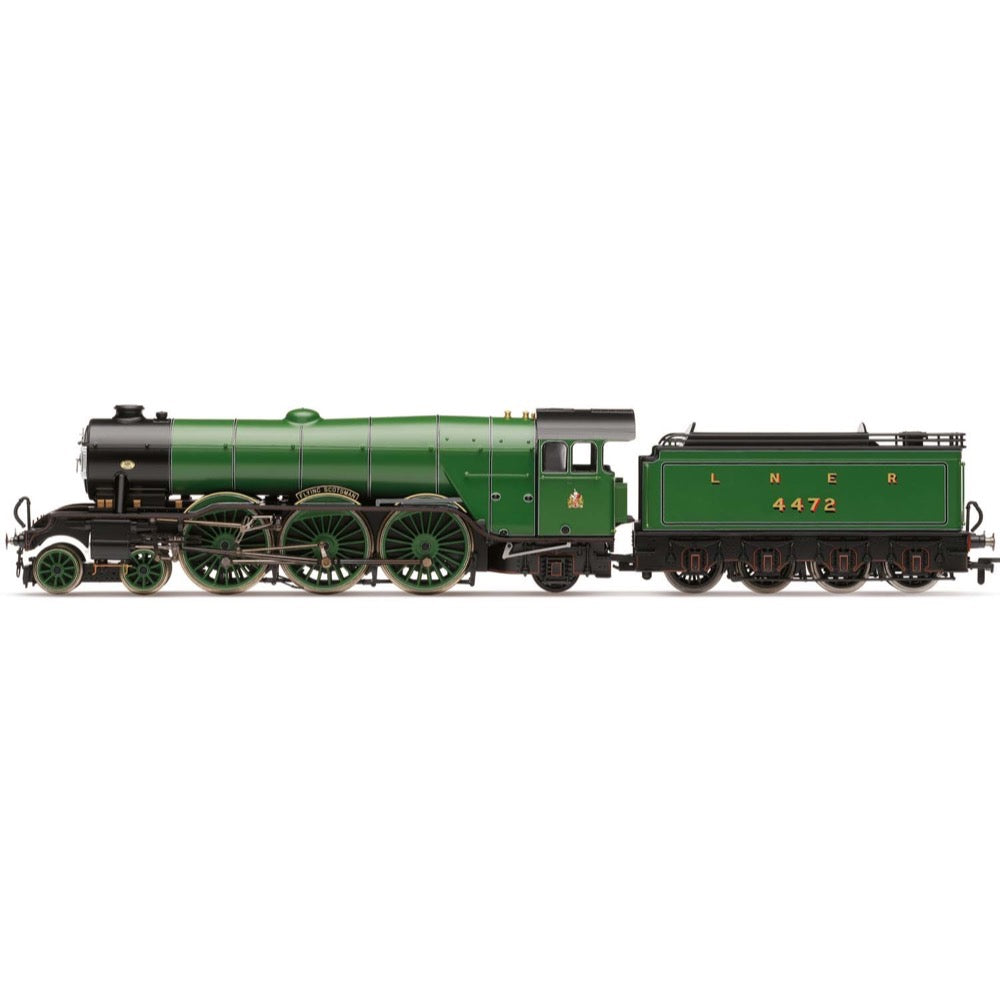
Hornby R3736 LNER A1 Class 4-6-2 4472 Flying Scotsman - Era 3
A1 Class 4472 Flying Scotsman entered traffic on 24 February, 1923, unnamed, as LNER No. 1472. Selected as the LNER's presitige exhibit for the forthcoming British Empire Exhibition at Wembley, 1472 emerged from Doncaster Works on 2 March, 1924 with the Company's Coat-of-Arms adorning the cabside, a new number; 4472 and named as Flying Scotsman.
On 1 May, 1928, and fitted with a Corridor Tender, Flying Scotsman undertook the first non-stop run from London to Edinburgh.
Specifications
- DCC status: DCC Ready 8 pin socket
- Finish: Pristine
- Gauge: OO
- Livery: Apple/Doncaster Green, Lined (Silver)
- Minimum radius curve: 2nd Radius (438mm)
- Motor: 5 Pole Skew wound
- Colour: Green
- Power pickup: Driving wheels and tender wheels
- Coupling: NEM / Tension lock
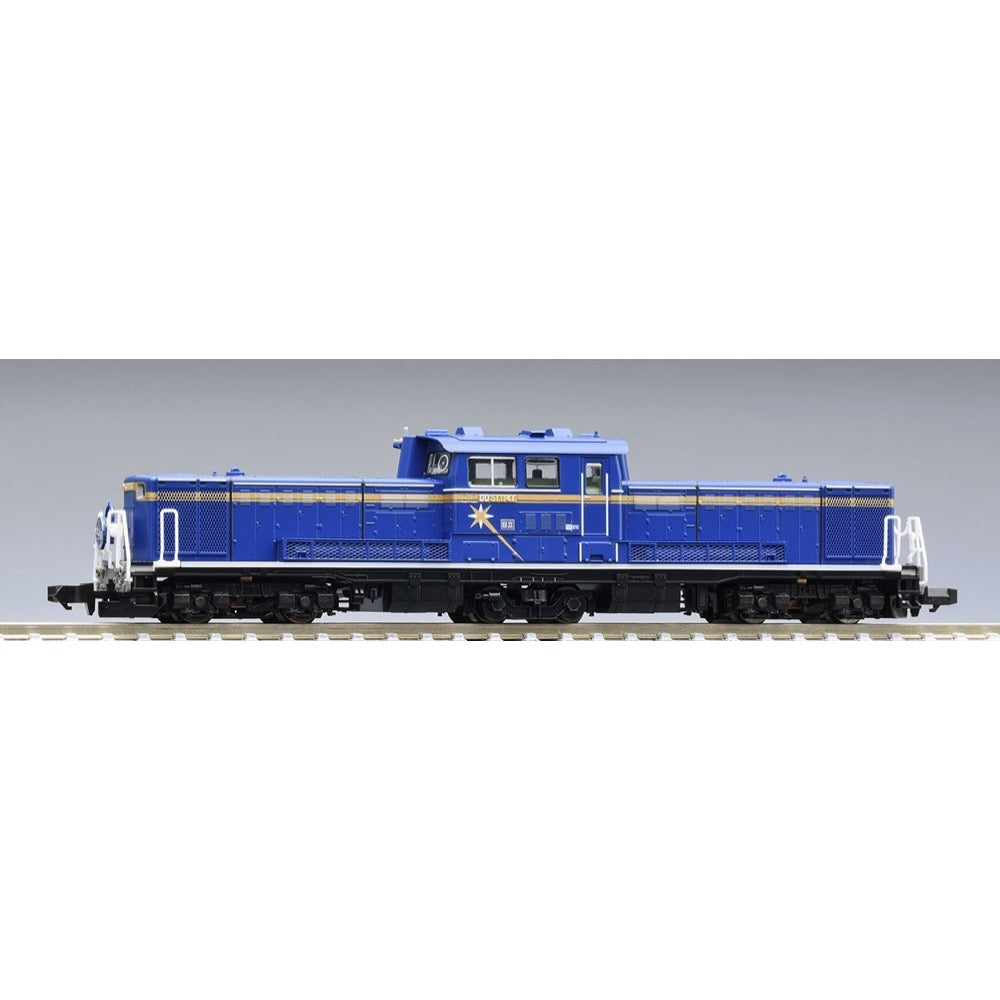
Tomix 2251 N DD51-1000 Type Diesel Locomotive JR Hokkaido
The DD51 series locomotives owned by JR Hokkaido were repainted in blue with a gold star mark to coincide with the start of operation of the sleeper express "Hokutosei." They were mainly used to pull passenger trains, including the "Hokutosei," but were retired in 2016 when the sleeper express "Cassiopea" and the express "Hamanasu" were discontinued.
Features
- High Grade (HG) specifications
- Reproduces the appearance of the Hokutosei color around 2006
- The handrail on the front deck reproduces the shape with a curved center
- The appearance of the roof ventilator placed next to the SG chimney is reproduced by a new production
- The deck step reproduces the shape with the wide bottom step by a new production
- Reproduces a vehicle with a train radio antenna on the front of the cab
- ATS on-board sub parts included
- The headlights are equipped with a constant lighting board and have an ON-OFF switch
- The headlights are lit by incandescent color LEDs
- The whistle and train radio antenna come as separate parts
- The H-rubber is reproduced in black
- Includes printed headmarks "Hokutosei, Cassiopeia, Hamanasu, Twilight Express"
- Includes headmark stay parts
- The number plate comes as a separate part "DD51-1137, 1138, 1141, 1148"
- Uses power with flywheel
- Uses black bogie frame and black wheels
- Includes dummy coupler and self-coupling type TN coupler
- Uses M-13 motor
Contents
Vehicle
- DD51-1000 (Hokutosei color)
Accessories
- Runner parts: Number plate
- Runner parts: Head mark
- Runner parts: Train radio antenna
- Runner parts: Manufacturer's plate
- Runner parts: Antenna base
- Runner parts: Head mark stay
- Runner parts: ATS on-board unit
- Parts: Automatic coupling type TN coupler
- Parts: Dummy coupler
- Parts: Dummy coupler receiver
- Parts: Jig
- Parts: Weight
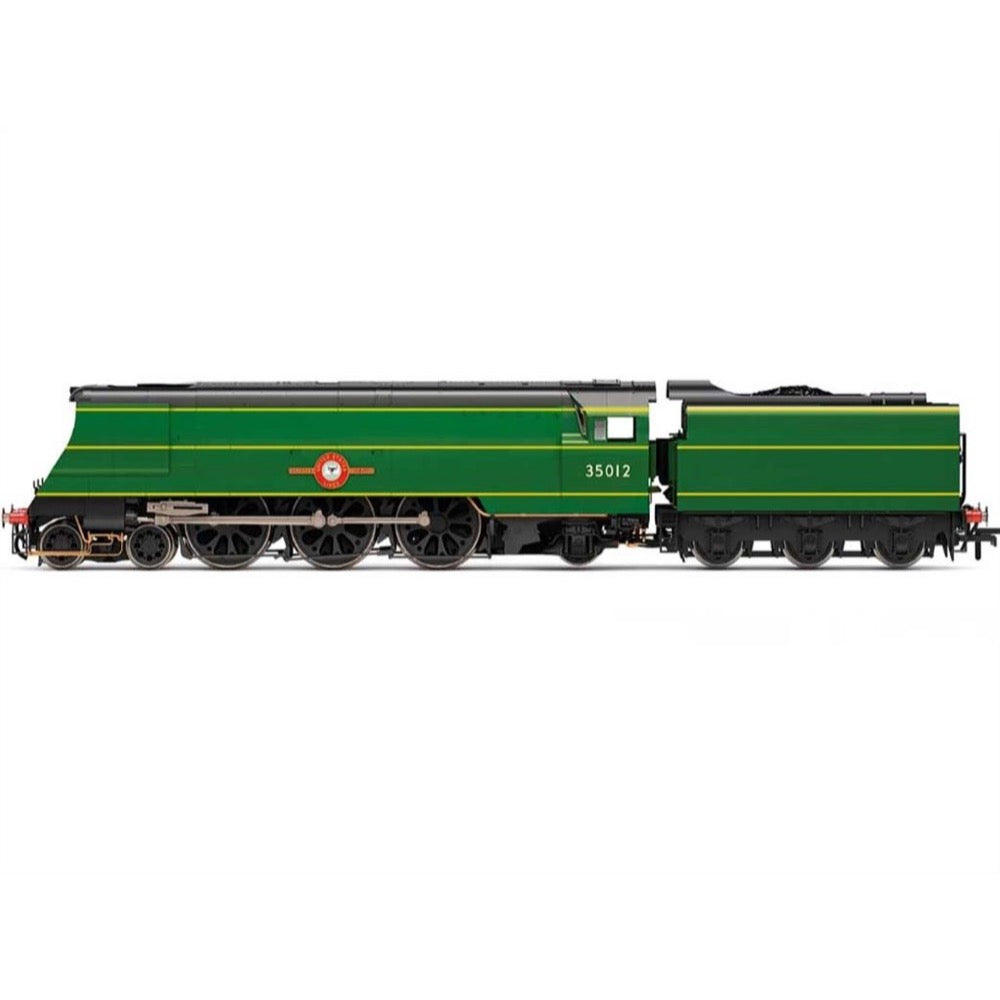
Hornby R3860 OO BR Merchant Navy Class 4-6-2 35012 United States Lines Era 4 Locomotive
Conceived in 1937 when Oliver Bulleid became Chief Mechanical Engineer of the Southern Railway, the Merchant Navy Class represented Bulleid's vision for a quick accelerating, mixed traffic 4-6-2 locomotive, equally capable of hauling passenger services (such as the Golden Arrow and Atlantic Coast Expresses), or freight workings, to a speed of around 75mph.
Mainly designed from the Brighton Works Drawing Office, under C.S Cocks, Bulleid, always aware of the practical applications and costing implications ensured that the best design practices of the time were applied to the new locomotive. Like his mentor, Nigel Gresley, Bulleid was a technically arrogant CME, an advocate for locomotives being driven hard and to brisk schedules and this materialised in his design ideas.
In 1934, Bullied had been opposed to the use of streamlining but for the Merchant Navy's 'air-smoothed' design is suited his purposes, being easy to clean mechanically and hiding the boiler's external pipes, which in turn meant that they could be run for function, rather than aesthetics. Opting for a welded steel firebox, instead of traditional copper construction for reduced weight and pressure benefits, Bulleid was able to make the three equally sized cylinders smaller, at 18', and better balanced.
New X-ray inspection techniques were specifically developed to monitor wear to the welded areas, whilst the newly designed Bulleid Firth Brown 6" 2' driving wheels reduced the amount of hammer blow to the rails, also resulting in less wear. Of all the new features Bulleid incorporated into the design, perhaps the most ingenious and, ultimately, most controversial was his decision to totally enclose the valve motion in an oil bath to prevent attritional wear through grit ingress.
Despite the onset of war in 1939, Bullied's design was accepted by the wartime Railway Executive Committee and production commenced though November 1940 at Eastleigh Works. The first member of the class, Channel Packet, was introduced in June of 1941 as the rather complicatedly numbered 21C1. Only 20 locomotives would be built under the SR, with a further 10 being built by BR entering straight into their service between 1948 and 1949. The last of the locomotives would be withdrawn towards the end of steam on BR in July of 1967.
Locomotive 35012 entered service with the Southern Railway in January 1945 with the palindromic locomotive 'number' 21C12. It would gain its more conventional number under BR before being rebuilt by the nationalised operator in February 1957, making it one of the first examples to be rebuilt. The locomotive would go on to serve under BR, mainly on the former Southern region before being withdrawn in April 1967. United States Lines would be scrapped in Newport shortly after.
The Hornby Merchant Navy is fitted with a powerful five pole motor and a large flywheel providing excellent performance. The locomotive if fitted with a fully detailed cab, tender pickups, NEM pockets front and rear and a 21 pin decoder socket.
Specification
- Item Length - Without Packaging (cm): 29.1
- Item Height - Without Packaging (cm): 5
- Item Width - Without Packaging (cm): 3.5
- Item Weight - Without Packaging: 0.44
- Item Scale: 1:76 Scale 00 Gauge
- Finish: Painted
- Colour: Green
- Gauge: OO
- DCC Status: DCC Ready 8 pin socket
- Operator: BR
- Designer: Oliver Bulleid
- Wheel Configuration: 4-6-2
- Livery: BR Malachite Green
- Minimum Curve (mm): Radius 2
- Motor: 5 Pole
- Number of Parts: 1
- Class: Merchant Navy Class
- Buffer Type: Sprung Metal Buffers
- Coupling Type: NEM Tension Lock
- Hornby Decoder Compatibility Primary: HM7000-21TXS: Bluetooth® & DCC Sound Decoder (21-pin)
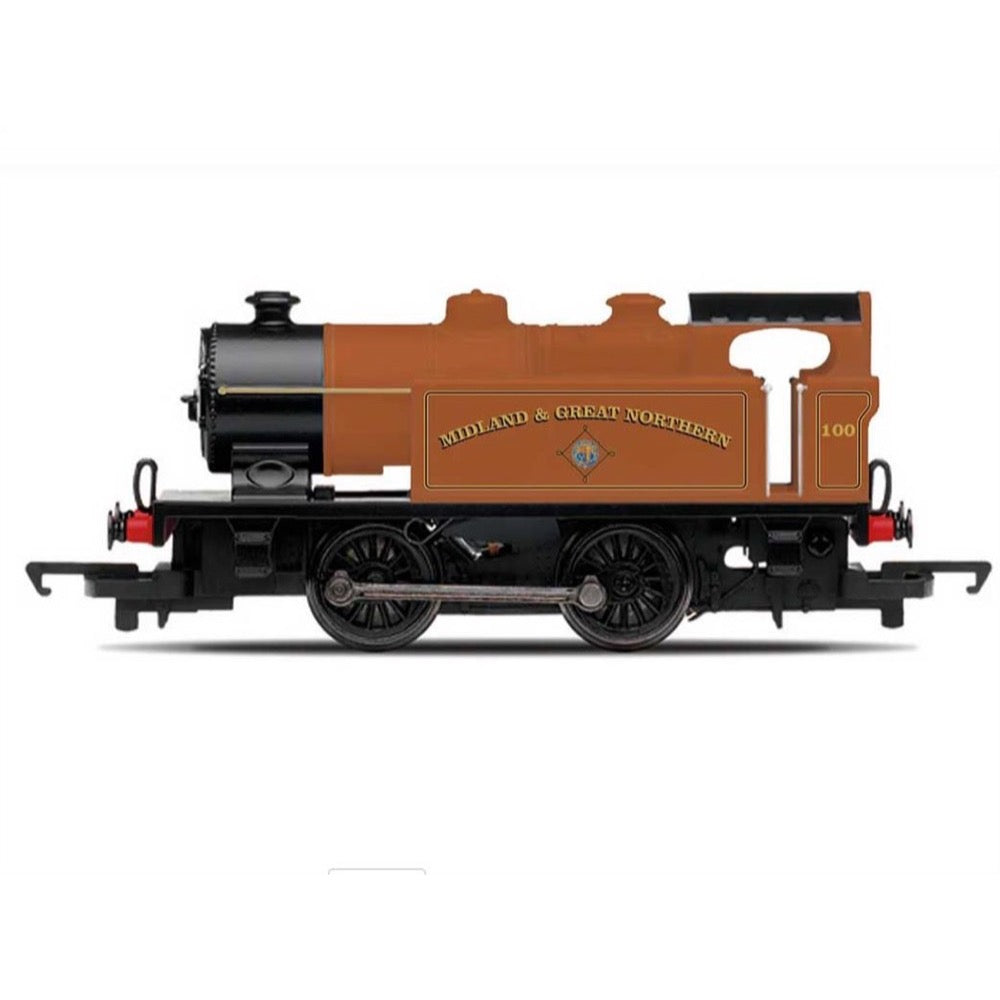
Hornby R30317 OO RailRoad M and GNJR 0-4-0T 100 Era 2 Locomotive
This small locomotive, painted in the resplendent livery of the pre-grouping M&GNJR, is representative of the kind you might have found shunting around dockyards or hauling mixed traffic on a light railway or branch line in the countryside. Small locomotives like this were easy to operate and maintain and were capable of traversing the tightest radius curves as would often be found in industrial settings. Should a locomotive need to traverse tighter curves that these locomotives could then narrow gauge would be the only way to go.
Specification
- Item Length - Without Packaging (cm): 10
- Item Height - Without Packaging (cm): 4
- Item Width - Without Packaging (cm): 3.5
- Item Weight - Without Packaging: 0.12
- Item Scale: 1:76 Scale 00 Gauge
- Finish: Painted
- Colour: Orange
- Gauge: OO
- Operator: M&GNJR
- Wheel Configuration: 0-4-0
- Livery: M&GNJR Orange
- Minimum Curve (mm): Radius 2
- Motor: 3 Pole
- Number of Parts: 1
- Buffer Type: Moulded Plastic Buffers
- Coupling Type: Fixed Tension Lock
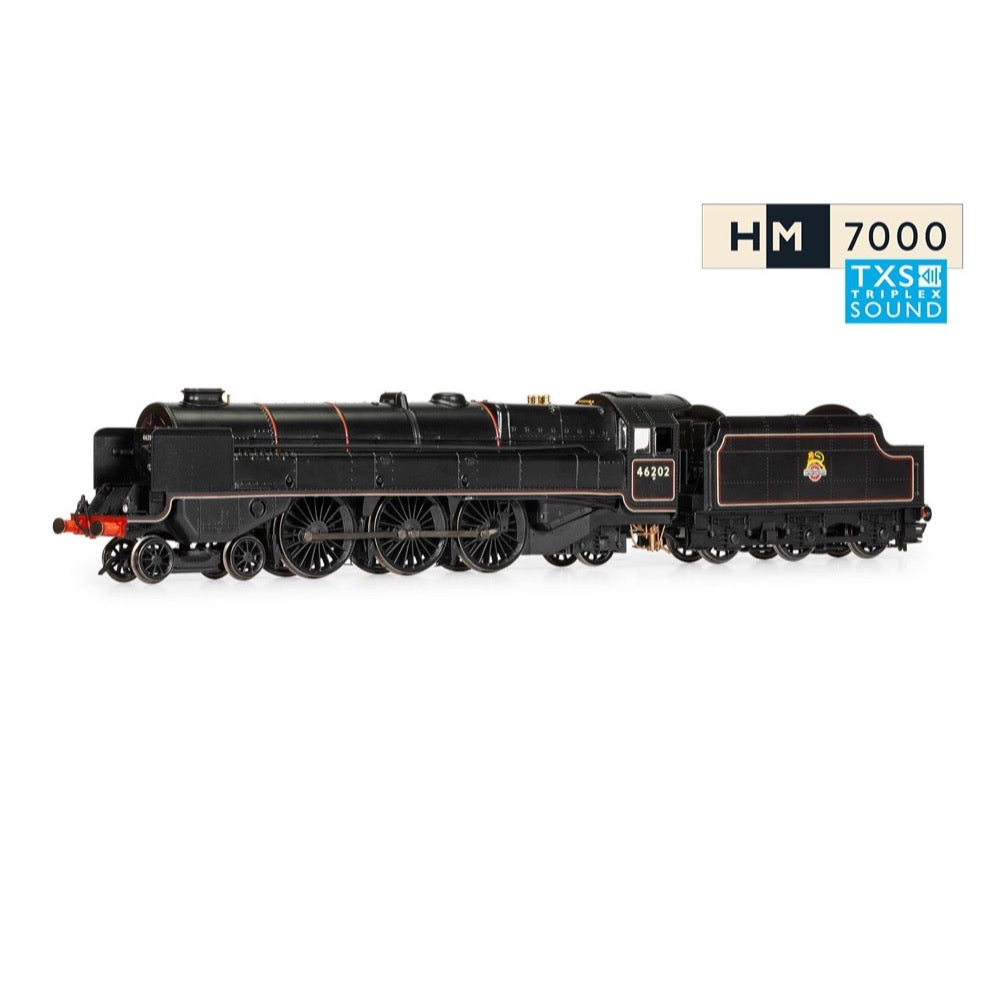
Hornby R30135TXS OO BR Princess Royal Class The Turbomotive 4-6-2 46202 Era 4 Sound Fitted
With the nationalisation of Britain’s railways, the ‘Princess Royal’ Class Turbomotive later shed its LMS insignia, to be replaced with the new emblem of British Rail and a black livery shortly after receiving its new crest. After a long period of general repair, Turbomotive returned to the main line in 1947 under the number 46202, continuing its function as a distinct and entirely uniquely designed steam turbine locomotive.
Specification
- Item Length - Without Packaging (cm): 30
- Item Height - Without Packaging (cm): 5
- Item Width - Without Packaging (cm): 3.5
- Item Weight - Without Packaging: 0.6
- Item Scale: 1:76 Scale 00 Gauge
- License: No
- Finish: Painted
- Colour: Black
- Gauge: OO
- DCC Status: Sound fitted
- Operator: BR
- Designer: Sir William Stanier
- Wheel Configuration: 4-6-2
- Livery: BR Black
- Minimum Curve (mm): Radius 2
- Motor: 5 Pole Skew wound
- Number of Parts: 1
- Buffer Type: Sprung Metal Buffers
- Coupling Type: NEM Tension Lock
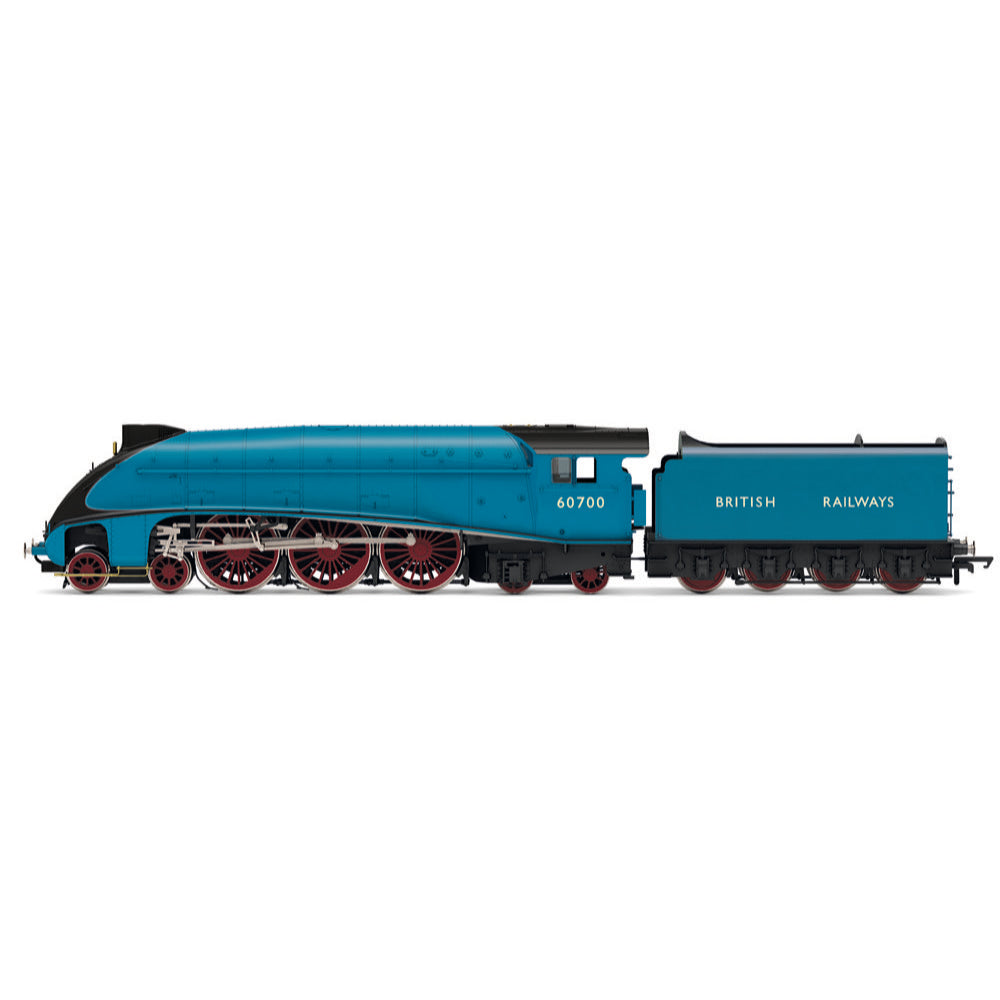
Hornby R30125 OO BR W1 Class Hush Hush Streamlined 4-6-4 60700
Having been rebuilt with a conventional boiler and A4 style streamlining in 1937, the W1 ‘Hush-Hush’ continued to serve with LNER and later British Railways. Under BR the locomotive was renumbered 60700 and used to operate regular services out of Kings Cross to Leeds and Cambridge, remaining with BR until scrapping in 1959.
Specification
- Item Length - Without Packaging (cm): 30.7
- Item Height - Without Packaging (cm): 5
- Item Width - Without Packaging (cm): 3.5
- Item Weight - Without Packaging: 0.44
- Item Scale: 1:76 Scale 00 Gauge
- Finish: Painted
- Colour: Blue
- DCC Status: DCC Ready 21 pin socket
- Operator: BR
- Designer: Sir Nigel Gresley
- Wheel Configuration: 4-6-4
- Livery: BR Blue
- Minimum Curve (mm): Radius 2
- Motor: 5 Pole Skew wound
- Number of Parts: 1
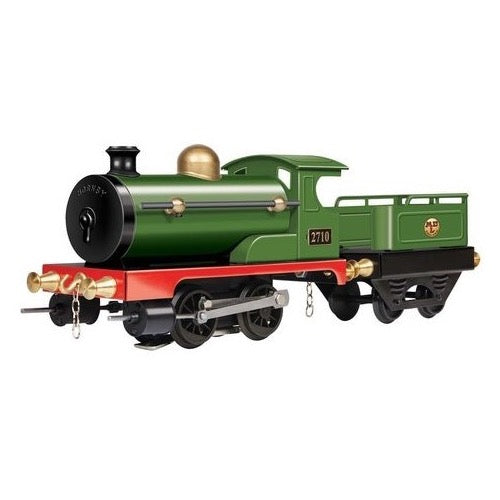
Hornby R3817 O Gauge 2710 GN No.1 Centenary Year Limited Edition 1920 Locomotive
With the Great War over and German toy trains not being imported due to the bitterness towards the vanquished, Frank Hornby saw an opportunity to expand his manufacturing business into the production of toy trains and consequently in 1920 he launched Hornby Trains.
Frank Hornby’s first British made Hornby ‘0’ gauge locomotives were produced in tinplate and assembled using nuts and bolts at the Meccano Ltd. factory situated in Binns Road, Liverpool. The first locomotive design of this construction was a simple generic style 0-4-0 locomotive using a clockwork mechanism and connected to a simple 4 wheel tender.
The No.1 0-4-0 Hornby ‘0’ Gauge locomotive design featured cylinders and connecting rods, plus brass handrail knobs. Also, all variants were fitted with cylinders with the bodies having an enamelled finish.
Inspired by the railway companies of the day, the first four tinplate ‘0’ gauge Hornby Trains locomotives produced respectively in 1920 were liveried in Midland Railway (MR) Maroon, London North Western Railway (LNWR) Black, Caledonian Railway (CR) Blue and Great Northern (GN) Green. These locomotives continued to be produced until 1923.
The four liveried Hornby Train replicas, using where possible the original Frank Hornby design have been produced as close to the original model specifications as possible but in place of a clockwork mechanism a 12vDC electric motor has been fitted allowing for three rail operation.
A Collector's Piece
Only 100 of these '0' Gauge highly collectable but functioning limited edition models have been exclusively produced in four liveries, reminiscent of the original tinplate locomotive produced by Frank Hornby in 1920, with each model authenticated by an individually signed and numbered certificate.
Collectors who order more than one design of these limited-edition products will receive the matching certificate number for each item making these an extra special addition to your highly exclusive collection. Serious collectors would be proud to own all four of these amazing collector pieces.
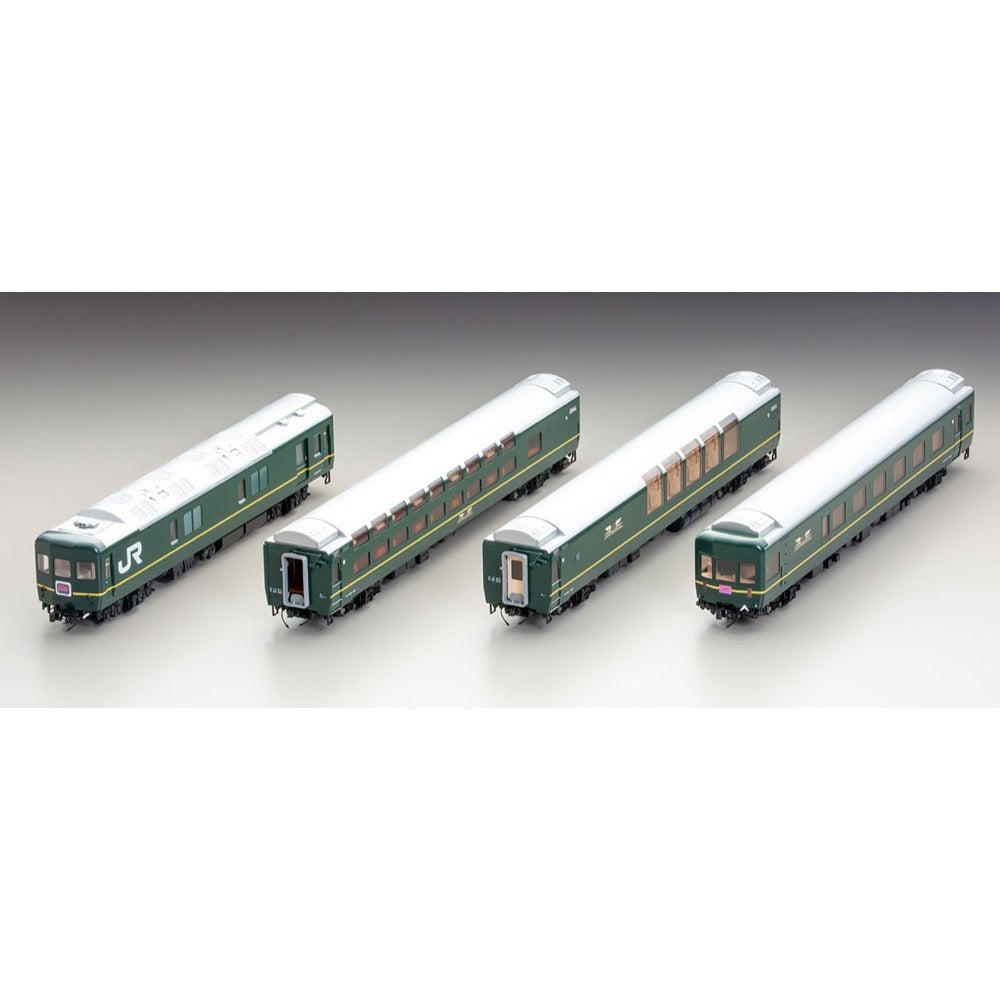
Tomix HO 24-25 Twilight Express Basic Set 4 Cars
The Twilight Express is a sleeper express train that first appeared in 1989. The 24 Series 25-type passenger cars used on this train are different from the traditional blue trains, with a green base and yellow stripes.
When the train first started, it had nine passenger cars, including the Kani 24-type, but in 1990, one more car was added, making it a 10-car train. Also, when the train first started, there were only two trains, but in 1991, a third train was added.
In the 2000s, the passenger cars were renovated, with silver stripes added above and below the yellow stripes on the body and interior changes, but the Twilight Express's operation between Osaka and Sapporo ended in March 2015.
Features
- Reproduces the appearance with silver bands added above and below the yellow band
- The Slonev 25-500 type is reproduced as it appeared after a rain gutter was installed on the observation room window
- Some markings such as model weight conversion notation are printed
- Car side indicator lights installed at the factory
- Shoe rails, door rails, JR mark, and logo mark are printed
- The train marking of the Kani 24 type and Slonev 25 type comes with a printed part "Twilight Express"
- The taillights and train marking of the Kani 24 type and Slonev 25 type are equipped with a circuit board
- The locomotive coupling side of the Kani 24 type and Slonev 25 type is equipped with a KD compatible type
- Closely coupled TN coupler is standard
- The side direction sign is reproduced with an internally applied sticker
- The car number is selectable and a transfer sheet is included
- Can pass through a minimum radius of R600 (excluding S-shaped lines)


